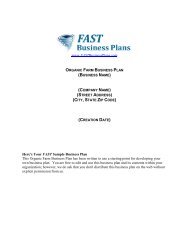Restaurant Business Plan Template - Fast Business Plans
Restaurant Business Plan Template - Fast Business Plans
Restaurant Business Plan Template - Fast Business Plans
You also want an ePaper? Increase the reach of your titles
YUMPU automatically turns print PDFs into web optimized ePapers that Google loves.
www.FAST<strong>Business</strong><strong>Plan</strong>s.com<br />
<strong>Restaurant</strong> <strong>Business</strong> <strong>Plan</strong><br />
The US restaurant industry includes about 480,000 restaurants with combined annual revenue of<br />
about $400 billion. Major companies include McDonald's; YUM! Brands (KFC, Pizza Hut, Taco<br />
Bell); and Darden <strong>Restaurant</strong>s (Olive Garden, Red Lobster). The industry is highly fragmented:<br />
the 50 largest companies hold just 20 percent of the market. (First Research).<br />
The industry consists of full-service restaurants (FSR) and limited service eating places, which<br />
include quick-service restaurants (QSR); cafeterias; buffets; snack bars; and nonalcoholic<br />
beverage bars. (First Research)<br />
4.1 Industry Analysis<br />
This analysis is based on the Standard Industry Code (“SIC”) 5812: Eating and Drinking<br />
Places Establishments primarily engaged in the retail sale of prepared food and drinks for<br />
on-premise or immediate consumption. It is also based on the North American Industry<br />
Classification System (“NAICS”) 722110 - Full-Service <strong>Restaurant</strong>s.<br />
This industry comprises establishments primarily engaged in providing food services to<br />
patrons who order and are served while seated (i.e., waiter/waitress services) and pay after<br />
eating. These establishments may provide food services to patrons in combination with<br />
selling alcoholic beverages, providing carry out services, or presenting live nontheatrical<br />
entertainment.<br />
Demographics, consumer tastes, and personal income drive demand. The profitability of<br />
individual companies can vary: while QSRs rely on efficient operations and high volume<br />
sales, FSRs rely on high-margin items and effective marketing. Large companies have<br />
advantages in purchasing, finance, and marketing. Small companies can offer superior<br />
food or service. The industry is labor-intensive. (First Research)<br />
Wages form a significant proportion of operating costs. The existence of a statutory<br />
minimum wage in most states increases the need for players to keep other costs as lean as<br />
possible, which in turn increases the importance of suppliers. A slight complication is that<br />
in some states, foodservice employers are able to treat tips received by their staff as<br />
contributing to their wages; in such states, this policy reduces the impact of the minimum<br />
wage from the employers' perspective. (Data Monitor)<br />
Annual revenue per worker is less than $50,000.<br />
<strong>Restaurant</strong>s compete with companies that serve meals or prepared foods, including grocery<br />
stores, warehouse clubs, delis, and convenience stores. In addition, restaurants compete<br />
with home cooking.<br />
Among FSRs, most establishments focus on Italian cuisine, steak, or seafood. Hamburger<br />
joints make up a majority of QSR locations, along with pizza parlors and sub sandwich<br />
shops. Industry revenue is roughly evenly split between FSRs QSRs.<br />
11






